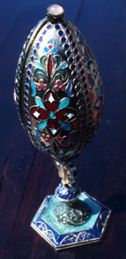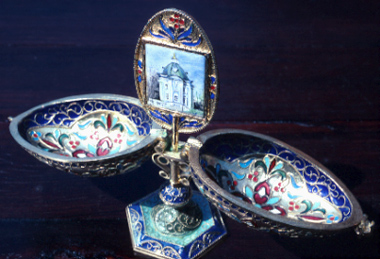 |
 |
Dr. Miroslaw Mrozowski
 |
 |
The late Dr. Miroslaw (pronounced Mir'oswaf) Mrozowski founded Melaloplastic in 1982. After retiring from chemistry, he devoted himself full-time to making a variety of work in metal, including icons and Judaic art. He was a member of the American Guild of Judaic Art and was awarded the Medal of Honor by the Nissenbaum Family Foundation. Dr. Mrozowski used modern technology and his own artistic skills to produce exquisite, affordable reproductions and originals.
|
Dr. Mrozowski adapted and perfected special electroforming and electroplating techniques to reproduce an original with incredible detail. On the left is a finished icon resting on its mold. To make an icon, Dr. Mrozowski prepared a master, then made a mold of it. |
|
The mold was then coated with metallic dust. |
|
Electrical contacts were attached to the mold, then it was immersed in a special solution. Here, Dr. Mrozowski lifts a piece that is being electroformed to show how it looks. |
|
Gradually, a thick layer of copper formed on the mold (wherever dust had been applied), faithfully duplicating all of the fine details. This copper blank was just removed from its mold. Two haloes are on the right of a Christ icon. The pieces will be sawed free, cleaned with sulfuric acid, enameled, then gold or silver plated. |
|
The faces, hands, and clothing were hand painted with tempera onto masonite. Shown are finished pieces assembled and prepared for shipment. Since these icons are easily confused with antique icons, Dr. Mrozowski included a certificate with the date of execution for customs officials. |
Secrets
of Icons In the beginning of the twentieth century, most people not
involved with Eastern Christianity were not aware of icons. The October Revolution (of
1917 in Russia) brought attention to the wealth of icon painting and other Russian art,
when the Soviet government used it as collateral to guarantee foreign loans. The early
publications of the Central Workshop of Reconstruction in Moscow are partially responsible
for the wide popularization and research of this splendid sphere of art. The West also
became interested in Byzantine and Early Christian art in the early twentieth century,
which created a suitable climate for collecting by museums, galleries, and the private
sector. |
For more information about Dr. Mrozowski's work, you can write
(in English) or speak (in Polish):
Metaloplastyka
ul. Kilejowa 43
93-487 Lodz
Poland
Telephone/fax: 011 48 42 684 41 76
LINKS:
Betancourt Icons of Guanajuato, Mexico
Czeslaw Olma, Polish Wood Carver
Jan Piotr Ledwon, Polish Wood Carver
Cloisonne enameling in Beijing
Silversmithing in Andalucia, Spain
Blacksmithing in Andalucia, Spain
Metal Spinning in Seville, Spain
Mexican Jeweler, Francisco Garcia Guevara
Metal Casters of Foumban, Cameroon, Africa
Lost Wax Casting in Krofofrom, Ghana
Haida Silversmith, Dave Hunter
Tinsmithing in Guanajuato, Mexico
Cloisonne enameling in Beijing
Web page, photographs, and text by Carol Ventura in 2000. Please look at
Carol's home page
to see more about crafts around the world.